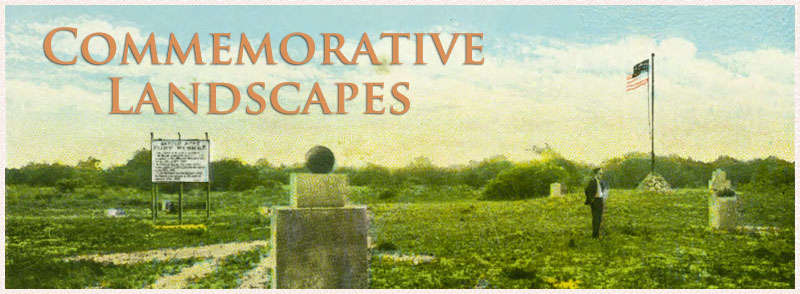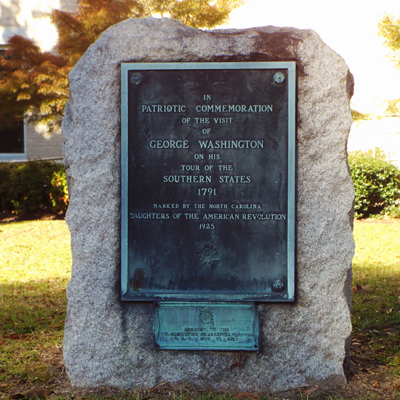
George Washington Plaque, Greenville
William Pfohl, Briggs-Shaffner Company, Winston Salem, NC, Builder
The marker commemorates President George Washington’s visit to the area during his tour of
the southern states in 1791. It consists of a two simple bronze plaques attached to a
roughhewn granite block several feet tall. The larger upper plaque contains the primary
inscription and is identical to the plaques in Tarboro, Hampstead and Guilford
Courthouse. The smaller bottom plaque provides dedication information. In addition to
the inscription, both plaques have the spinning wheel and distaff insignia of the Daughters of
the American Revolution.
Images:
Plaque
Top plaque: IN / PATRIOTIC COMMEMORATION / OF THE VISIT / OF / GEORGE WASHINGTON /
ON HIS / TOUR OF THE / SOUTHERN STATES / 1791 / MARKED BY THE NORTH CAROLINA /
DAUGHTERS OF THE AMERICAN REVOLUTION / 1925
Bottom plaque: ERECTED BY THE / COL. ALEXANDER MCALLISTER CHAPTER / D.A.R. NOV. 17,
1925
Greenville City Recreation and Parks
November 17, 1925
35.613380 , -77.373090
View in Geobrowse
Farnham, Thomas J. "Washington's Southern Tour," NCpedia.org, 2006 (accessed May 28, 2014) Link
George Washington Papers at the Library of Congress, 1741-1799: The Diaries of George Washington. In The Diaries of George Washington. Vol. VI. January 1790-December 1799, Donald Jackson and Dorothy Twohig, eds. Charlottesville: University Press of Virginia, 1979. (accessed December 14, 2013). Link
Henderson, Archibald. 1923. Washington’s Southern Tour 1791. Boston and New York: Houghton Miffin company, 1923, (accessed May 28, 2014) Link
Kammerer, Roger. "Pitt’s Past Column,” Joyner Library, East Carolina University, (accessed July 10, 2016) Link
“GW’s Southern Tour-Greenville NC,” Waymarking.com, (accessed July 11, 2016) Link
Yes
Granite, bronze
Colonel Alexander McAllister Chapter Daughters of the American Revolution
In the spring of 1791, President George Washington began his tour of the southern states. Washington decided even before his inauguration to visit every state in the nation in order to gain a better understanding of the condition of the country and the needs of the people. His cross-country journey began in 1789 but, because North Carolina did not ratify the United States Constitution until 1790, his trip to the south was delayed.
Between March and June of 1791, Washington traveled along the eastern seaboard from Maryland to Georgia, and then took a western return route from Georgia to Virginia. During his 1,700-mile tour he sought to emphasize national unity, understand the region's political sentiments, and learn about the southern economy. North Carolina was of particular importance to the tour because of its late ratification and Washington used his stops in the state as an opportunity to reinforce its admittance into the union.
Washington was revered as the father of the nation and, because of his status; his visits to communities across the country were of important historical significance.
There are numerous markers across North Carolina commemorating President Washington's
tour of the southern states in 1791 to include nine identical bronze plaques placed by the DAR in 1925.
Notable among them are
George Washington Plaque, Hampstead outside Wilmington,
George Washington Plaque, Tarboro,
George Washington Plaque, Salisbury,
and
George Washington Plaque, Guilford Courthouse.
Other markers made of stone include
George Washington and Henry Clay Marker in Wilmington,
George Washington Boulder in Lexington and
"George Washington Stopped Here" Marker in Arcadia.
The monument sits near the sidewalk in front of the Pitt County Courthouse to the left of the entrance. A small memorial to Pitt County Peace officers is nearby. To the right of the courthouse entrance is the Pitt County Confederate Monument. The courthouse is located at 100 W. Third Street in Greenville, NC.
The marker stands on the front lawn under a mature shady tree.
 Know anything else about this monument that isn't mentioned here? If you have additional information on
this or any other monument in our collection fill out the form at the Contact Us link in the footer. Thank you.
Know anything else about this monument that isn't mentioned here? If you have additional information on
this or any other monument in our collection fill out the form at the Contact Us link in the footer. Thank you.

